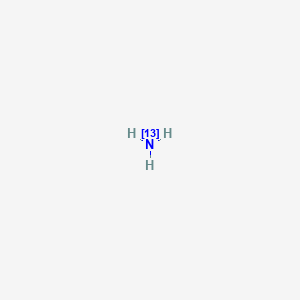



1. Ammonia N 13
2. Ammonia-(sup 13)n
3. ((sup 13)n)ammonia
4. Ammonia N13
5. 34819-78-8
6. Ammonia, N-13
7. 9oqo0e343z
8. (13n)ammonia
9. [13n]ammonia
10. 13n-ammonia
11. N-13 Ammonia
12. Ammonia N 13 Injection
13. Ammonia N 13 [usan]
14. Unii-9oqo0e343z
15. Ammonia N 13 [usan:usp]
16. Ammonia-13n
17. Nitrogen, Isotope Of Mass 13, At.
18. Ammonia-(13)n
19. Ammonia (13n)
20. Ammonia ((13)n)
21. Ammonia N 13 (tn)
22. Ammonia N 13 (usp)
23. Chembl1201189
24. Chebi:135980
25. 13nh3
26. Dtxsid601027603
27. Moli001000
28. Moli001060
29. [13n]nh3
30. Ammonia (13n) [who-dd]
31. Ammonia N-13 [orange Book]
32. Ammonia N 13 [usp Impurity]
33. (13)nh3
34. Ammonia, N-13 [orange Book]
35. Db09326
36. H3[(13)n]
37. D02915
38. Q27098001
| Molecular Weight | 16.030 g/mol |
|---|---|
| Molecular Formula | H3N |
| XLogP3 | -0.7 |
| Hydrogen Bond Donor Count | 1 |
| Hydrogen Bond Acceptor Count | 1 |
| Rotatable Bond Count | 0 |
| Exact Mass | 16.029214 g/mol |
| Monoisotopic Mass | 16.029214 g/mol |
| Topological Polar Surface Area | 1 Ų |
| Heavy Atom Count | 1 |
| Formal Charge | 0 |
| Complexity | 0 |
| Isotope Atom Count | 1 |
| Defined Atom Stereocenter Count | 0 |
| Undefined Atom Stereocenter Count | 0 |
| Defined Bond Stereocenter Count | 0 |
| Undefined Bond Stereocenter Count | 0 |
| Covalently Bonded Unit Count | 1 |
| 1 of 2 | |
|---|---|
| Drug Name | Ammonia n 13 |
| Active Ingredient | Ammonia n-13 |
| Dosage Form | Injectable |
| Route | Intravenous |
| Strength | 30mci-300mci/8ml (3.75-37.5mci/ml); 3.75-260mci/ml |
| Market Status | Prescription |
| Company | Ucsf Rodiopharm; Feinstein; Johns Hopkins Univ; Ucla Biomedical; Cardinal Health 414; Wa Univ Sch Med; Shertech Labs; Univ Tx Md Anderson; Houston Cyclotron; Mcprf; Kreitchman Pet Ctr |
| 2 of 2 | |
|---|---|
| Drug Name | Ammonia n 13 |
| Active Ingredient | Ammonia n-13 |
| Dosage Form | Injectable |
| Route | Intravenous |
| Strength | 30mci-300mci/8ml (3.75-37.5mci/ml); 3.75-260mci/ml |
| Market Status | Prescription |
| Company | Ucsf Rodiopharm; Feinstein; Johns Hopkins Univ; Ucla Biomedical; Cardinal Health 414; Wa Univ Sch Med; Shertech Labs; Univ Tx Md Anderson; Houston Cyclotron; Mcprf; Kreitchman Pet Ctr |
For diagnostic Positron Emission Tomography (PET) imaging of the myocardium under rest or pharmacologic stress conditions to evaluate myocardial perfusion in patients with suspected or existing coronary artery disease.
FDA Label
Following intravenous injection, ammonia N 13 enters the myocardium through the coronary arteries. The PET technique measures myocardial blood flow based on the assumption of a three-compartmental disposition of intravenous ammonia N 13 in the myocardium. In this model, the value of the rate constant, which represents the delivery of blood to myocardium, and the fraction of ammonia N 13 extracted into the myocardial cells, is a measure of myocardial blood flow. Optimal PET imaging of the myocardium is generally achieved between 10 to 20 minutes after administration.
V - Various
V09 - Diagnostic radiopharmaceuticals
V09G - Cardiovascular system
V09GX - Other cardiovascular system diagnostic radiopharmaceuticals
V09GX05 - Ammonia (13N)
Absorption
Following intravenous injection, 13N-ammonia is cleared rapidly from the blood with a biologic half-life of about 2.84 minutes (effective half-life of about 2.2 minutes). In the myocardium, its biologic half-life has been estimated to be less than 2 minutes (effective half-life less than 1.67 minutes).
Route of Elimination
Urinary excretion mainly as urea N 13.
Volume of Distribution
0.8 ml/g.
Clearance
The radioactivity cleared from the blood very rapidly with 85% clearance in the first minute.
Ammonia N 13 undergoes a five-enzyme step metabolism in the liver to yield urea N 13 (the main circulating metabolite). It is also metabolized to glutamine N 13 (the main metabolite in tissues) by glutamine synthesis in the skeletal muscles, liver, brain, myocardium, and other organs. Other metabolites of ammonia N 13 include small amounts of N 13 amino acid anions (acidic amino acids) in the forms of glutamate N 13 or aspartate N 13.
2.84 minutes.
Ammonia N 13 Injection is a radiolabeled analog of ammonia that is distributed to all organs of the body after intravenous administration. It is extracted from the blood in the coronary capillaries into the myocardial cells where it is metabolized to glutamine N 13 and retained in the cells. The presence of ammonia N 13 and glutamine N 13 in the myocardium allows for PET imaging of the myocardium.